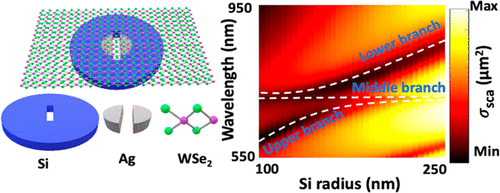当前位置:
X-MOL 学术
›
ACS Photonics
›
论文详情
Our official English website, www.x-mol.net, welcomes your
feedback! (Note: you will need to create a separate account there.)
Boosting Strong Coupling in a Hybrid WSe2 Monolayer–Anapole–Plasmon System
ACS Photonics ( IF 6.5 ) Pub Date : 2021-01-14 , DOI: 10.1021/acsphotonics.0c01470 Khalil As’ham 1 , Ibrahim Al-Ani 1 , Lujun Huang 1 , Andrey E. Miroshnichenko 1 , Haroldo T. Hattori 1
ACS Photonics ( IF 6.5 ) Pub Date : 2021-01-14 , DOI: 10.1021/acsphotonics.0c01470 Khalil As’ham 1 , Ibrahim Al-Ani 1 , Lujun Huang 1 , Andrey E. Miroshnichenko 1 , Haroldo T. Hattori 1
Affiliation

|
The exciton–polaritonic states are generated by the strong interaction between photons and excitons in confined nanocavities. To achieve strong coupling between excitons in TMDCs and optical modes in cavities is quite challenging due to fabrication issues, modal and material dispersion in the cavity, and the weak confinement of the optical field. Hence, investigation of new photonic structures to achieve strong coupling in TMDCs materials is necessary to develop polariton-based devices. Here, we report the observation of the strong coupling between an anapole mode in a slotted silicon nanodisk and an exciton in a WSe2 monolayer, leading to the creation of anapole–exciton polaritons. Furthermore, we have also demonstrated a strong anapole–plasmon and anapole–plasmon–exciton coupling in Si–Ag, and Si–Ag–WSe2 heterostructures, respectively. The observed polaritonic hybrid states have a large Rabi splitting (159 meV) accompanied by high localized field enhancement (157 times increase) in the near field and at a normal incident angle, suggesting a crucial step toward the creation of exciton–polariton nanodevices.
中文翻译:

增强WSe 2单层-极-等离子体混合系统中的强耦合
激子-极化子态是由有限的纳米腔中光子和激子之间的强相互作用产生的。由于制造问题,模腔和材料在模腔中的色散以及光场的弱限制,要实现TMDCs中激子与腔中光学模式之间的强耦合是非常具有挑战性的。因此,研究新的光子结构以实现TMDCs材料之间的强耦合是开发基于极化子的器件所必需的。在这里,我们报告了在开槽的硅纳米盘中的偶极子模式与WSe 2单分子层中的激子之间的强耦合的观察结果,从而导致了偶极子-激子极化子的产生。此外,我们还证明了Si-Ag和Si-Ag-WSe中强的偶极子-等离子体激元和偶极子-等离子体激元-激子耦合分别为2个异质结构。观察到的极化混合态具有大的拉比分裂(159 meV),伴随着近场和垂直入射角的高局部电场增强(增加157倍),这表明向激子-极化纳米器件的制造迈出了关键的一步。
更新日期:2021-02-17
中文翻译:

增强WSe 2单层-极-等离子体混合系统中的强耦合
激子-极化子态是由有限的纳米腔中光子和激子之间的强相互作用产生的。由于制造问题,模腔和材料在模腔中的色散以及光场的弱限制,要实现TMDCs中激子与腔中光学模式之间的强耦合是非常具有挑战性的。因此,研究新的光子结构以实现TMDCs材料之间的强耦合是开发基于极化子的器件所必需的。在这里,我们报告了在开槽的硅纳米盘中的偶极子模式与WSe 2单分子层中的激子之间的强耦合的观察结果,从而导致了偶极子-激子极化子的产生。此外,我们还证明了Si-Ag和Si-Ag-WSe中强的偶极子-等离子体激元和偶极子-等离子体激元-激子耦合分别为2个异质结构。观察到的极化混合态具有大的拉比分裂(159 meV),伴随着近场和垂直入射角的高局部电场增强(增加157倍),这表明向激子-极化纳米器件的制造迈出了关键的一步。











































 京公网安备 11010802027423号
京公网安备 11010802027423号